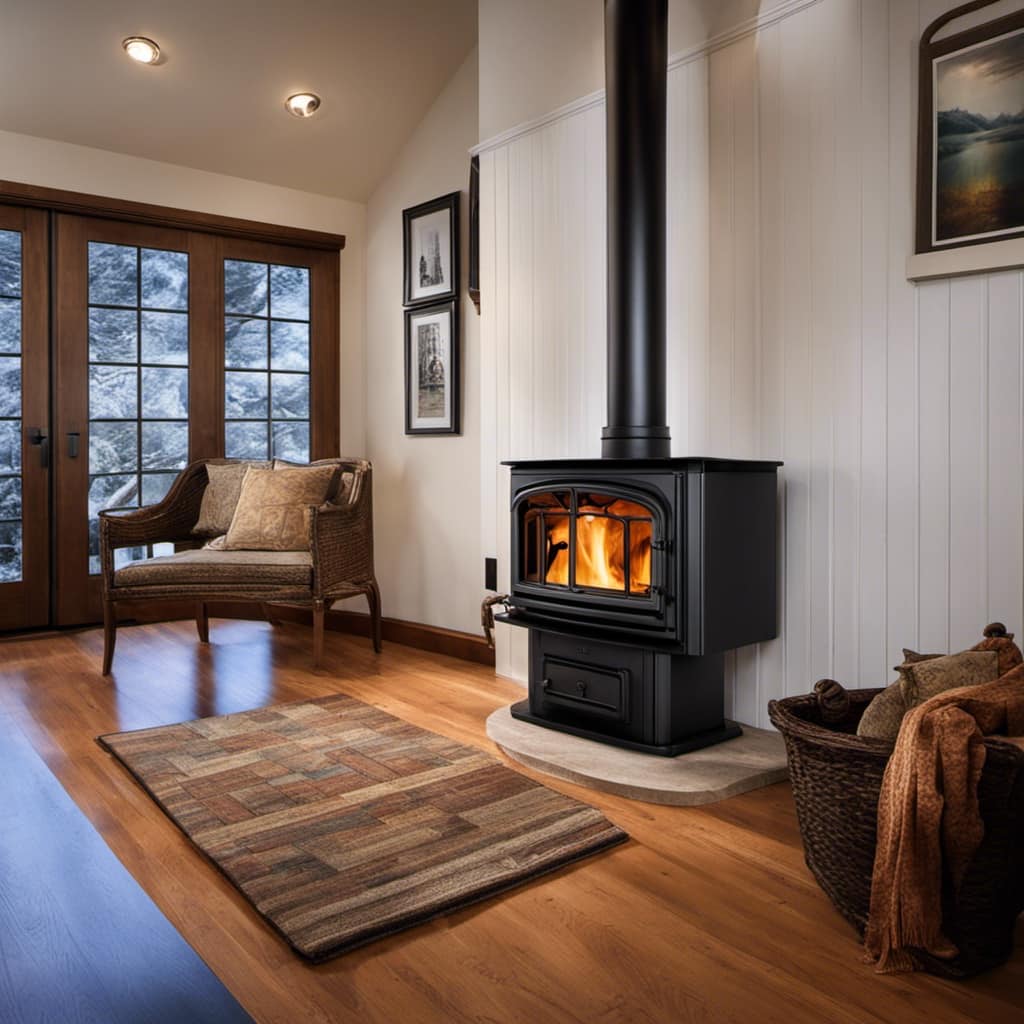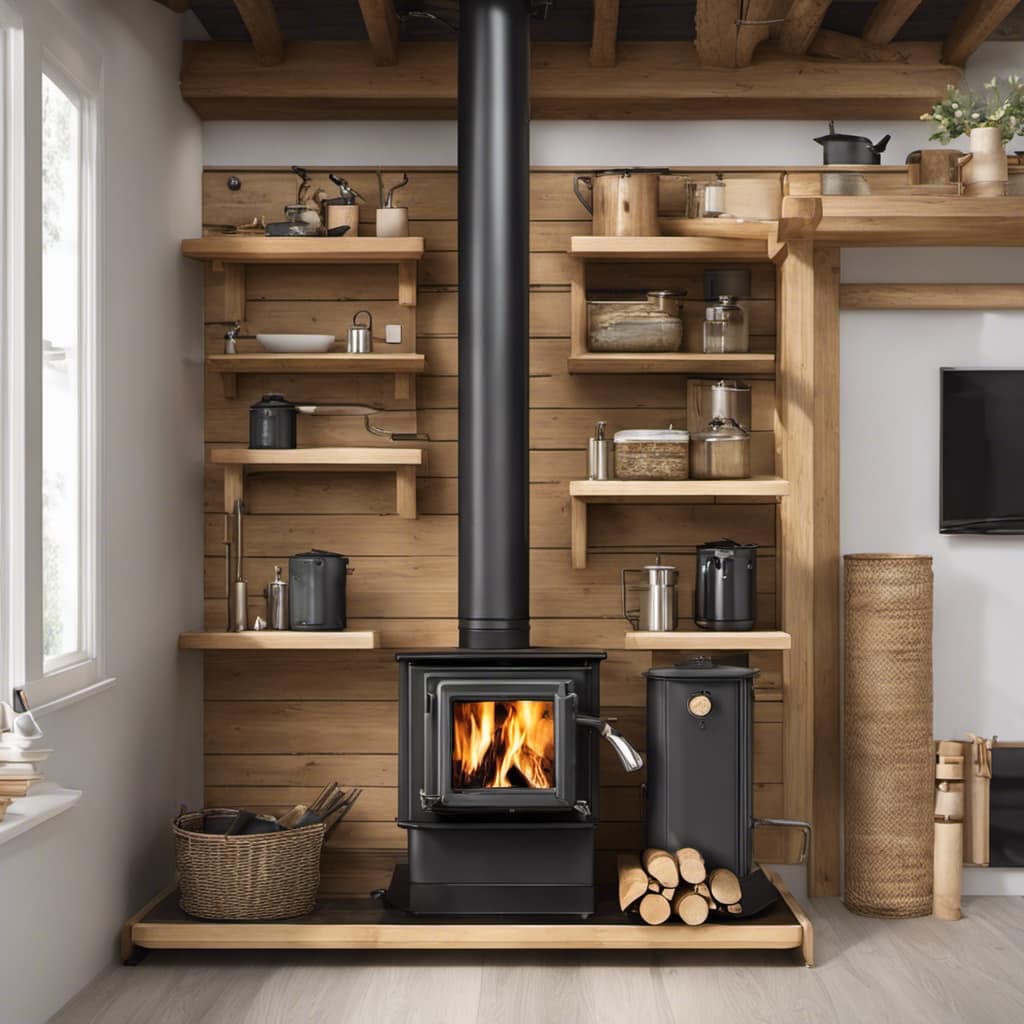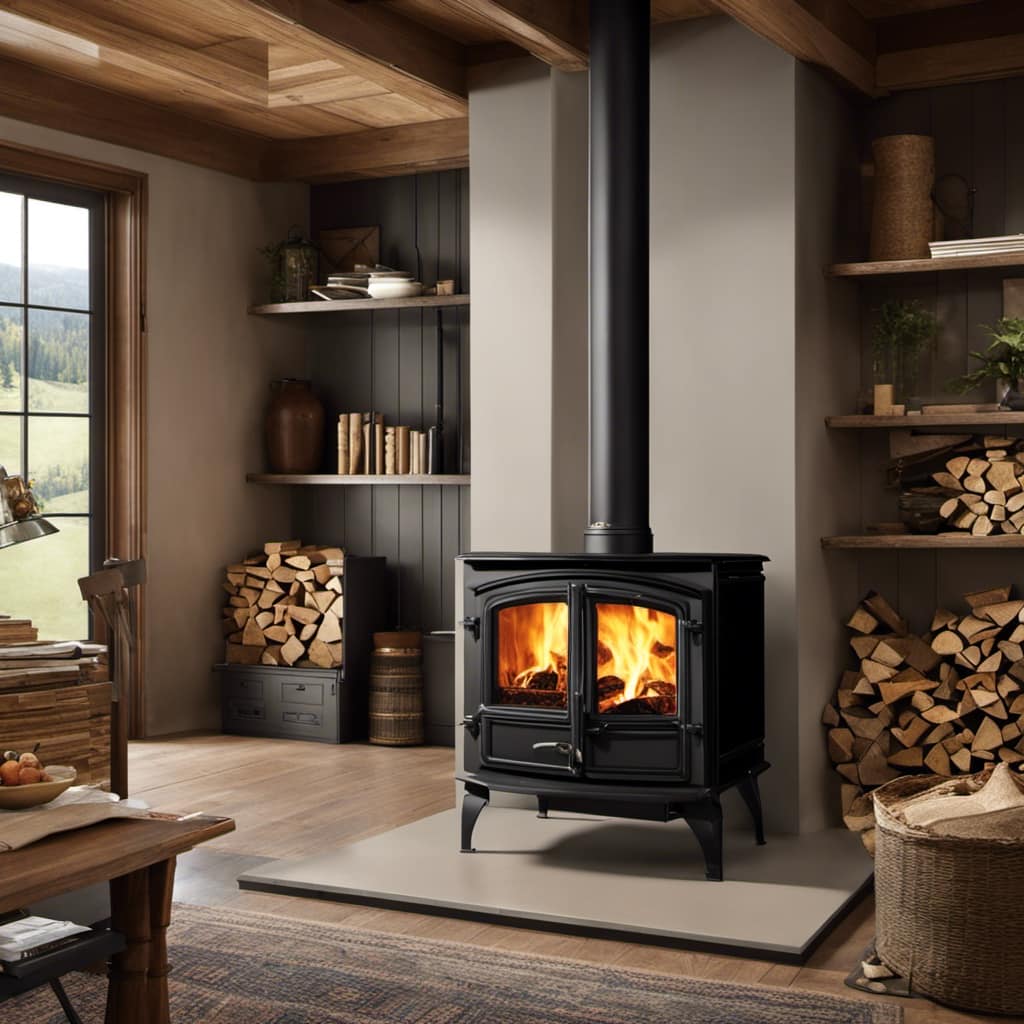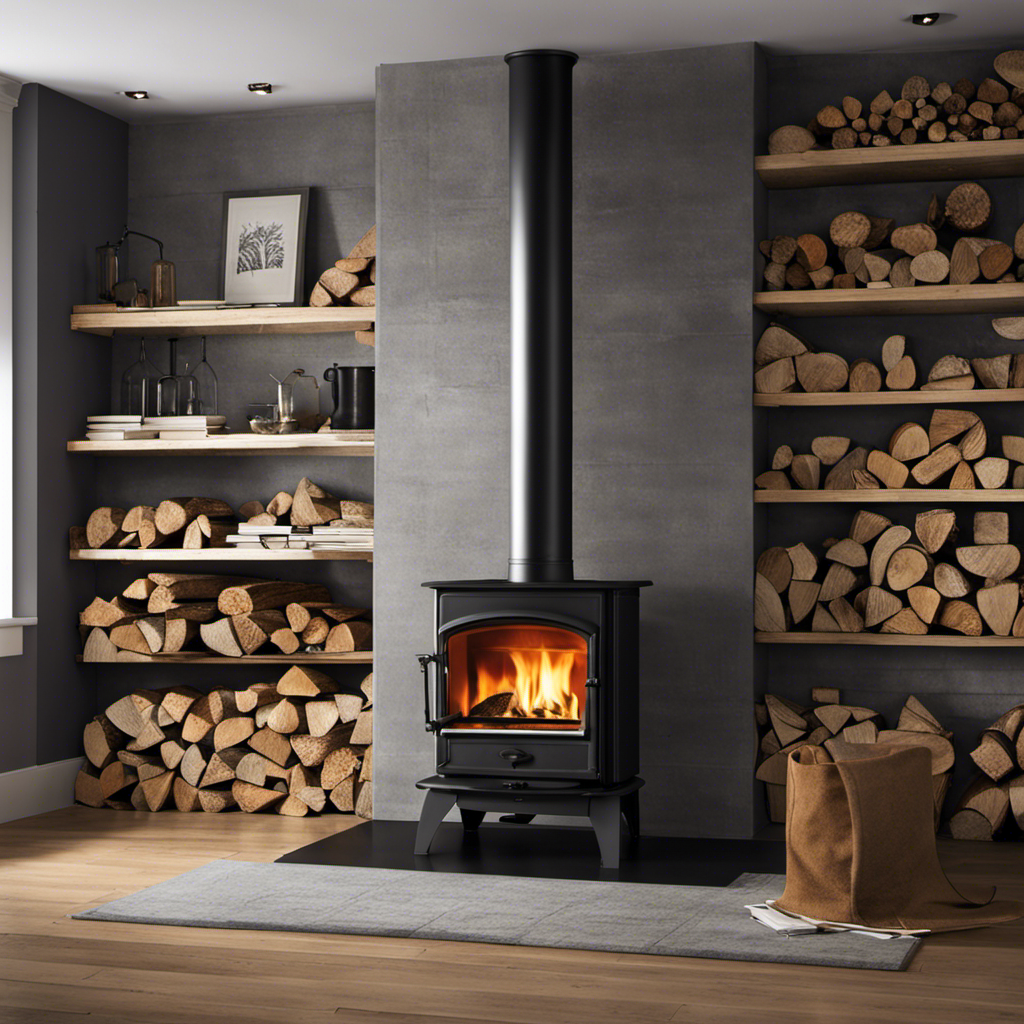- "Alternative cleaning methods for removing black residue from wood stove glass"
- "The importance of regularly cleaning wood stove glass and how it affects performance"
I know how frustrating it can be to look at a dirty, soot-covered glass on a wood stove. But fear not, my friend, because I have discovered the solution.
In this article, I will show you the tried and true methods to clean that stubborn black residue off your wood stove glass. With a few simple steps and some handy cleaning supplies, you’ll be enjoying a crystal clear view of your roaring fire in no time.
Let’s get started!
Key Takeaways
- Burning certain types of wood, especially softwoods, can cause black buildup.
- Incomplete combustion releases volatile compounds that condense on the glass surface.
- Vinegar mixed with water is highly effective in removing black buildup.
- Regularly clean the inside of the wood stove to reduce residue on the glass.
Understanding the Causes of Black Buildup on Wood Stove Glass
I’ve noticed that the black buildup on my wood stove glass is caused by the burning of certain types of wood. When I burn softwoods like pine or spruce, I tend to see more residue formation compared to hardwoods like oak or cherry.

This black buildup is primarily a result of incomplete combustion, where the wood doesn’t burn completely and releases volatile compounds that condense on the glass surface. To prevent this residue formation, it’s important to ensure proper airflow and maintain a hot fire.
Using dry, seasoned wood also helps as it burns more efficiently. Additionally, regular cleaning of the glass with a specialized cleaner or a mixture of vinegar and water can help remove any existing buildup and prevent it from becoming stubborn and difficult to clean in the future.
Gathering the Necessary Cleaning Supplies
I’ll need to go to the store to get some vinegar and water for cleaning the wood stove glass.
When it comes to choosing the right cleaning solution, vinegar mixed with water is highly effective in removing black buildup from wood stove glass. The acidic properties of vinegar help break down the soot and grime, leaving your glass clean and clear.

To properly protect the surrounding area, it’s essential to lay down a drop cloth or newspaper to catch any drips or spills. This will prevent any potential damage to your flooring or furniture. Additionally, wearing gloves and using a soft cloth or sponge will ensure a thorough and safe cleaning process.
Preparing the Glass for Cleaning
Before starting the cleaning process, it’s important to carefully inspect the glass and remove any large debris. This step is crucial to ensure a successful cleaning and to prevent any damage to the glass surface.
Once the glass is clear of debris, you can proceed to tackle the grease stains. Grease stains on the glass can be stubborn and difficult to remove, but with the right technique, it can be done effectively.
One way to remove grease stains is by using a mixture of vinegar and water. Simply spray the solution onto the glass and let it sit for a few minutes. Then, use a soft cloth or sponge to gently scrub the stains away.

To prevent future buildup, it’s recommended to regularly clean the glass and avoid burning materials that produce excessive smoke.
By following these steps, you can keep your wood stove glass clean and clear for a cozy and enjoyable fire.
Now, let’s move on to discussing the effective cleaning techniques for removing black residue.
Effective Cleaning Techniques for Removing Black Residue
One effective cleaning technique for removing black residue is to combine baking soda and water, and then use a sponge to scrub the surface. This DIY cleaning solution is not only efficient but also safe for your wood stove glass. To prevent black residue buildup in the first place, it is important to properly maintain and operate your wood stove. Regularly cleaning the glass and avoiding burning wet or unseasoned wood can help minimize the amount of black residue that accumulates. Additionally, using a high-quality fuel source and ensuring proper airflow in your wood stove can also contribute to reducing black residue. By following these preventive measures and utilizing effective cleaning techniques, you can keep your wood stove glass looking clean and clear.

| Preventing black residue | DIY cleaning solutions |
|---|---|
| Properly maintain wood stove | Baking soda and water |
| Avoid burning wet wood | Vinegar and water |
| Use high-quality fuel | Lemon juice and salt |
| Ensure proper stove airflow | Dish soap and warm water |
Maintaining a Clean and Clear Wood Stove Glass
To maintain a clean and clear wood stove glass, I regularly wipe it down with a damp cloth and vinegar solution. This simple technique helps to remove any soot or residue that may have built up over time, improving visibility and ensuring a more enjoyable fire-viewing experience.
Additionally, there are a few other tips and tricks that can help prevent future buildup and maintain the cleanliness of your wood stove glass:
-
Use a glass cleaner specifically designed for wood stoves. These cleaners are formulated to effectively remove stubborn stains and leave your glass looking crystal clear.
-
Avoid burning wet or green wood. Moisture in the wood can lead to more smoke and soot buildup on the glass.

-
Regularly clean the inside of your wood stove. By keeping the interior clean and free from ash and debris, you can reduce the amount of residue that accumulates on the glass.
Frequently Asked Questions
Can I Use Regular Glass Cleaner to Clean the Black Residue off My Wood Stove Glass?
Yes, regular glass cleaner is not recommended for cleaning black residue off wood stove glass. Instead, try using vinegar as a natural cleaner and a microfiber cloth for better results.
How Often Should I Clean the Glass on My Wood Stove?
I typically clean the glass on my wood stove every couple of weeks to maintain its clarity. To ensure the best results, I use a combination of vinegar and water or a specialized glass cleaner made for wood stoves.
Can I Use a Razor Blade to Scrape off the Black Buildup on the Glass?
I wouldn’t recommend using a razor blade to clean black buildup off wood stove glass. While it may remove the residue, there’s a risk of scratching or damaging the glass. It’s best to use safer cleaning methods to avoid any potential harm.

Is It Safe to Use Abrasive Cleaners on Wood Stove Glass?
Yes, it is safe to use abrasive cleaners on wood stove glass. However, there are alternative cleaning methods that can effectively remove black residue without damaging the glass. Regular cleaning is important for optimal stove performance.
What Are Some Alternative Cleaning Methods for Removing Black Residue From Wood Stove Glass?
There are alternative cleaning methods for removing black residue from wood stove glass. Natural cleaning solutions can be effective in getting rid of the buildup. Let me share some tips and tricks.
Conclusion
In conclusion, keeping the glass of your wood stove clean is essential for maintaining its efficiency and visual appeal.
By understanding the causes of black buildup, gathering the necessary cleaning supplies, and using effective techniques, you can easily remove residue and maintain a clear glass.

Think of your wood stove glass as a window to a warm and cozy world, and with proper care, it will continue to shine brightly, enhancing the beauty of your home.
Growing up surrounded by the vast beauty of nature, Sierra was always drawn to the call of the wild. While others sought the comfort of the familiar, she ventured out, embracing the unpredictable and finding stories in the heartbeat of nature.
At the epicenter of every remarkable venture lies a dynamic team—a fusion of diverse talents, visions, and passions. The essence of Best Small Wood Stoves is crafted and refined by such a trio: Sierra, Logan, and Terra. Their collective expertise has transformed the platform into a leading authority on small wood stoves, radiating warmth and knowledge in equal measure.











